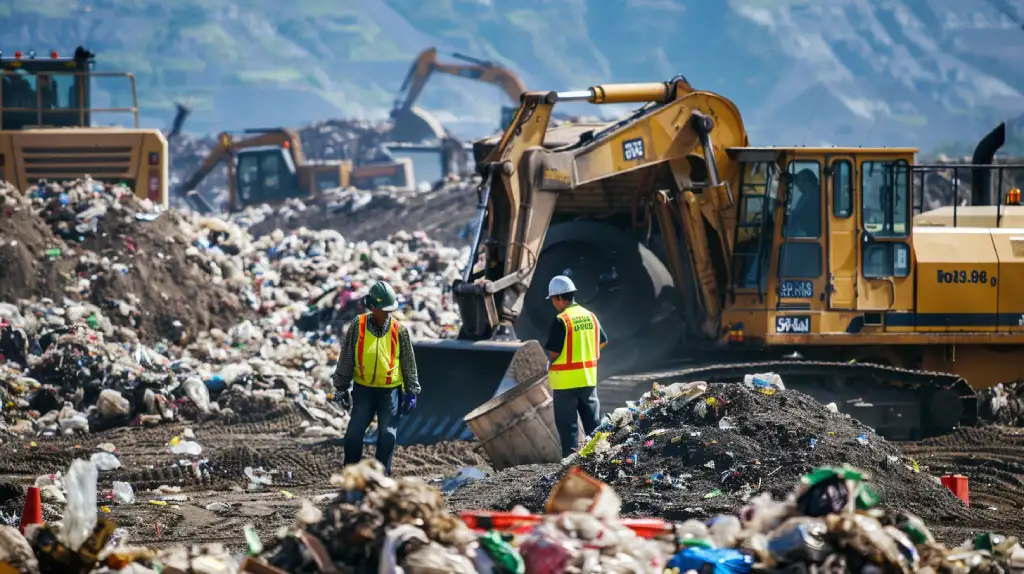Solid waste in landfills can contribute to air pollution in several ways. Landfills can release harmful gases such as methane and VOCs, leading to air pollution.
Landfills are the end point for much of the waste we generate daily. While they are crucial in managing waste, they are also big sources of environmental pollution, particularly air pollution.
Understanding how solid garbage in landfills contributes to air pollution is important for handling this issue and protecting both our health and the environment.
This article will explore the connection between landfill waste and air pollution, the broader environmental impacts, and solutions to reduce these harmful effects.
Air pollution is the contamination of the air by harmful substances. These pollutants can come from various sources, including vehicle emissions, industrial processes, and household activities.
Pollution can lead to health problems, contribute to climate change, and harm ecosystems.
How Solid Garbage in Landfills Can Result in Air Pollution

Solid garbage in landfills can result in air pollution when it decomposes and releases harmful gases into the atmosphere.
Solid waste in landfills can contribute to air pollution in several ways:
- Methane emissions: As organic materials in landfills decompose, they produce methane, a potent greenhouse gas that contributes significantly to air pollution and climate change.
- VOC emissions: Volatile organic compounds (VOCs) can be released from various items in landfills, including paints, solvents, and cleaning products. These VOCs can react with other pollutants in the atmosphere to form ozone, a harmful air pollutant.
- Dust and particulate matter: Landfills can generate dust and particulate matter, which can be carried by the wind and contribute to air pollution.
- Burning of waste: If landfill waste is not properly managed or accidentally sparked, it can release harmful gases and particulate matter into the atmosphere.
Overall, the improper disposal of solid waste in landfills can have a big harmful impact on air quality and the environment.
What is Solid Garbage in Landfills?
Solid garbage includes all the non-hazardous waste produced by households, businesses, and industries. This includes everyday items such as packaging, food scraps, paper products, and discarded goods. When this waste is not recycled or composted, it is generally transported to landfills, where it piles up over time.
The large volume of waste in landfills leads to large mounds of garbage, some of which do not decompose easily. This buildup poses various environmental risks, including the potential for air, water, and soil contamination.
Moreover, the improper disposal litter and electronic waste, such as discarded computers, in landfills can contribute to air pollution as toxic materials are released into the atmosphere.
How Landfills Generate Air Pollution
Decomposition and Gas Emission
One of the primary ways landfills contribute to air pollution is through the decomposition of organic waste.
When organic materials, such as food scraps and plant matter, break down in the absence of oxygen (a process known as anaerobic decomposition), they release methane and carbon dioxide.
Methane is a potent greenhouse gas, approximately 25 times more effective at trapping heat in the atmosphere than carbon dioxide. This gas contributes greatly to global warming.
Additional Pollutants
Besides methane, landfills also emit other harmful pollutants, including volatile organic compounds (VOCs) and hazardous air pollutants (HAPs).
These substances can evaporate into the atmosphere, reducing air quality and posing health risks to communities near landfills.
The combination of these pollutants creates a big environmental challenge that must be resolved to protect public health and the environment.
Environmental Impact of Air Pollution from Landfills

Impact on Air Quality and Health
Air pollution from landfills has a direct impact on the health of nearby residents. Exposure to pollutants such as methane, VOCs, and HAPs can lead to respiratory issues, cardiovascular diseases, and other serious health problems. Also, poor air quality can worsen existing health conditions, particularly for weak populations such as children and the elder people.
The release of methane and other greenhouse gases from landfills accelerates climate change by contributing to the warming of the planet.
This warming can lead to extreme weather events, sea-level rise, and shifts in ecosystems that disrupt plant and animal life. Furthermore, pollutants from landfills can seep into the soil and water, contaminating natural resources and harming wildlife.
The environmental impact of air pollution from landfills is far-reaching, affecting not only human health but also the overall health of the planet.
Solutions to Reduce Landfill-Related Air Pollution
To reduce the harmful effects of air pollution from landfills, several measures can be implemented. First, reducing the amount of waste that ends up in landfills is essential.
This can be achieved through increased recycling, composting, sustainable practices and adopting more sustainable consumption habits. Also, modern landfill technologies, such as methane capture systems, can help reduce emissions by collecting and using the gas as an energy source.
By taking these steps, we can decrease the environmental footprint of landfills, improve air quality, and create a healthier environment for future.
Proper waste management begins with the correct storage of trash and recyclables. Trash should be kept in tightly sealed bins to prevent odors and deter pests, while recyclables should be cleaned and sorted into designated containers to avoid contamination.
Keeping recyclables dry and free from food waste assures that they can be effectively processed. Regularly separating waste and recyclables at the source helps reduce the amount of material sent to landfills, ultimately lowering the environmental impact.
Recycling is crucial in reducing the waste that ends up in landfills and contributes to air pollution. By converting materials such as plastic, metal, glass, and paper into new products, recycling conserves natural resources and decreases the need for raw materials.
This process reduces the energy consumption and greenhouse gas emissions linked with manufacturing new items. Motivating recycling habits, both at the household and industrial levels, can highly cut down landfill waste, helping to reduce its environmental impact and improve air quality.
The Bottom Line
The connection between solid garbage in landfills and air pollution is clear.
As waste continues to gather in landfills, the potential for environmental harm grows. However, by taking proactive steps to manage waste more effectively and adopting advanced landfill technologies, we can highly reduce the impact of air pollution from landfills.
This not only protects our environment but also safeguards public health, making sure a sustainable future.
FAQ's
1. How do landfills contribute to air pollution?
Landfills contribute to air pollution primarily through the decomposition of organic materials, which releases harmful gases such as methane and volatile organic compounds into the atmosphere.
2. How does solid waste contribute to air pollution?
Solid waste in landfills can contribute to air pollution by decomposing and releasing harmful gases like methane and volatile organic compounds.




